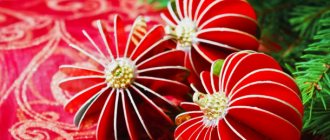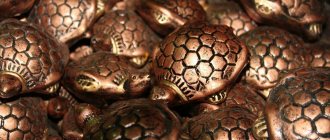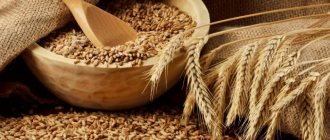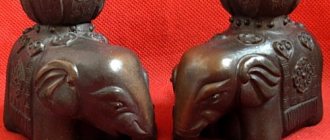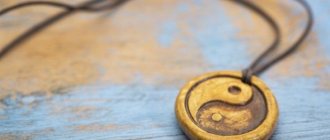Content
- 1 Early characters
- 2 Theravada symbolism
- 3 Mahayana symbolism
- 4 Vajrayana iconography 4.1 Architecture of Tibetan Buddhism
- 4.2 Color in Tibetan Buddhism
- 4.3 Thangkas (paintings) and statues of Buddhas and deities
- 5.1 Ritual robes
Early characters[ | ]
Footprint of Buddha with images of triratna and Dharmachakra.
I century AD, Gandhara. Despite the many surviving images, it remains unclear what role they played in early Buddhism, since their symbolic meaning was not clearly explained in early texts. Among the earliest and most common symbols of Buddhism are the stupa[1] (with relics in it), the Dharmachakra[2] (wheel of Dharma), the Bodhi Tree (and the individual leaves of this tree with their special shape) and the lotus flower. The Wheel of Dharma, which traditionally has eight spokes, can have different interpretations. Initially, it symbolized only royal power (Chakravartin - “the one who turns the wheel”), but already in the 3rd century BC. on the Ashoka Pillar it is depicted in a Buddhist context. The image of the Wheel of Dharma is usually associated with the historical process of transmission of Buddhism, the eight spokes with the Noble Eightfold Path. The lotus can also have several meanings, often related to compassion and the concept of the mind's inherently pure potential. The Bodhi Tree is the place where Buddha achieved nirvana and therefore symbolizes liberation.
Other early symbols include the monastic alms bowl and trishula[3]. This last symbol has been in use since about the 2nd century. BC. and combined the lotus, vajra (diamond) and the symbolism of the triratna or “three jewels”: Buddha, dharma and sangha. The lion, the riderless horse, and the deer were also used in early Buddhist iconography. The sutras liken the Buddha's teachings to a "lion's roar", emphasizing their strength and nobility. The riderless horse represents renunciation, and the deer represents Buddhist disciples, since the Buddha delivered his first sermon at the Deer Grove in Varanasi.
The swastika in India has traditionally been used by Buddhists and Hindus to symbolize good luck.[4] In East Asia, the swastika is often seen as a general symbol of Buddhism. Swastikas used in this context can be left-handed or right-handed.
Early Buddhism did not depict the Buddha himself, but used an empty throne and the Bodhi Tree to represent him, that is, it probably gravitated towards aniconism. The first hint of the image of a person in Buddhist symbolism is the appearance of the footprint of the Buddha, and complete images appear only thanks to Greco-Buddhist art.
Historical roots of Buddhist stupas
Since time immemorial, there has been a tradition of erecting a mound at human burial sites. This was done so that descendants would remember their ancestors. In India, stupas appeared in those times when Buddhism was not formed as a philosophy and religion . Initially, such graves were created around trees, placing the remains of a cremated body in them. Over time, the remains of people who were outstanding in some respects began to be placed in stupas. You can read more about the philosophy of Buddhism in this article .
The word “stupa” from Sanskrit has several meanings : “top of the head”, “knot of hair”, “pile of stones and earth”. Sacred remains, clothes of an enlightened teacher, and texts can be stored in such structures. In some cases, a Buddhist stupa was erected in honor of some memorable event and does not contain relics.
During the life of Buddha, stupas were also erected, including in his honor. There are four reliquary and three memorial stupas that personified the path of Siddhartha after leaving the palace.
Buddha himself wanted a stupa to be erected over his remains (received the name Mahaparinirvana Sutra), which became the object of an offering not to him personally, but to his mind - the personification of wisdom and enlightenment.
Buddhist stupa in Sanchi. India
After his death, the Buddha's body was cremated with full honors. In Buddhism, it is believed that after the burning of the Buddha's body, the remains were divided into eight parts. For each of these parts, corresponding buildings were built at different places in India. They were called “Great Reliquary Stupas”. Two more stupas were erected for the burial of the vessel in which the Buddha was cremated, as well as for the ashes from his funeral pyre.
At the same time, as Buddhism began to spread beyond India, such structures began to appear in Indonesia, Sri Lanka, Vietnam, Cambodia, Thailand, Laos, Burma, Tibet, China, Kalmykia, Buryatia, Tyva, and Mongolia.
Theravada symbolism[ | ]
In Theravada, Buddhist art served only to represent the Buddha and his story. Reminders of the Buddha were divided into relics, places and images.
Although the Buddha was first depicted in human form only around the 1st century,[5] the Buddha's bodily characteristics are already described in one of the central texts of the traditional Pali Canon, the Digha Nikaya, in a part called the Sutra of Attributes (Pali: Lakkhaṇa Sutta , D.iii.142 et seq.).
These characteristics consist of 32 marks, "32 bodily attributes of the Great Man" (Pali: Lakkhaṇa Mahāpurisa 32). These were supplemented by another 80 secondary characteristics (Pali: anubyañjana).
Mahayana symbolism[ | ]
Lotus flower on the temple bell.
As if floating above the dirty waters of attachment and desire, the lotus symbolizes purity of body, speech and mind. Mahayana Symbols: Ashtamangala In the Mahayana schools, the meaning of Buddhist figures and sacred objects tended to be esoteric and symbolic. Mudras are symbolic movements of the hands that describe the actions of the most important characters in Buddhist art. Many of the images also act as mandalas.
Mahayana and Vajrayana Buddhist art often uses the "eight auspicious emblems"[6] (Sanskrit aṣṭamaṅgala, Chinese: 八吉祥; pinyin: ba jíxiáng) in everyday and public art. Thanks to Buddhism, these symbols have spread into the art of many cultures, including Indian, Tibetan, Nepalese and Chinese.
Eight good emblems (Ashtamangala):
- Lotus flower. Symbolizes purity and enlightenment.
- Endless knot or mandala. Symbolizes eternal harmony.
- Gold fish. Symbolizes marital happiness and freedom.
- Victory Banner. Symbolizes a victorious battle.
- Wheel of Dharma. Symbolizes knowledge.
- Precious vase. Symbolizes inexhaustible treasures and riches.
- Good umbrella. Symbol of the crown and protection from the elements.
- White shell. Symbolizes the thoughts of Buddha.
In East Asian Buddhism, the swastika is widely used as a symbol of eternity. It is used to indicate Buddhist temples on maps and at the beginning of Buddhist sources. In classical Tibetan it is known as yungdrung (Wiley transcription: g.Yung drung)[7]. In ancient Tibet, it served as a graphic representation of eternity[8].
In Zen Buddhism, a widely used symbol is the enso, a hand-drawn circle.
Types of amulets
Figurines of the god of luck, happiness and fun come in different sizes.
The larger one can be placed on the floor in the house facing the door . For a medium-sized figure, place it on a shelf or chest of drawers. It’s convenient to always take the tiny one with you, and it will support you in any situation.
The most powerful amulets are those of white or golden color.
Traditional materials in ancient times were:
- tree;
- bone;
- fangs;
- animal horns.
Later they began to make them from metals, including precious ones, from glass, from stones:
- disgrace;
- jade;
- Agatha.
Now made from:
- coral;
- porcelain;
- clay;
- plaster and even plastic.
It is believed that the material is not particularly important. The main thing is that the figurine pleases the owner, is carefully selected taking into account intentions and desires, and is correctly placed in the house according to Feng Shui. It is important that she is always well-groomed, surrounded by attention and honor.
Next you can see the types of figurines of the god of luck.
Porcelain Buddha:
Hotei on a toad:
Golden Hotei:
Cheerful Buddha made of wood:
Cheerful Buddha on coins:
Vajrayana iconography[ | ]
Architecture of Tibetan Buddhism[ | ]
Eight types of Tibetan stupas Vishwavajra, or “double vajra”, in the emblem of Bhutan
The central symbol of the Vajrayana is the Vajra, the sacred indestructible weapon of the god Indra, associated with lightning and the hardness of diamond. It symbolizes emptiness (shunyata) and therefore the indestructible nature of reality.
Other Vajrayana symbols include the ghanta (ritual bell), the bhavachakra wheel of existence, mandalas, the number 108 and the eyes of Buddha, which are commonly seen on Nepalese stupas such as those at Boudhanath. Various mythical creatures are also used in Vajrayana: Snow Lion, Wind Horse, Dragon, Garuda and Tiger.
The well-known mantra “om mani padme hum” symbolizes compassion and is commonly found inscribed on stones, prayer wheels, stupas and works of art.
The main structure in the architecture of Tibetan Buddhism is the stupa, called “chorten” in Tibetan (Wiley: mchod rten). The chorten has five parts which represent the Mahabhuta (five elements)[9]. The base of the stupa is a square (symbolizing the earth element), above which is a dome (symbolizing water), on which is a cone (symbolizing fire), on the tip of the cone is a crescent (symbolizing air), inside the crescent is a flame (symbolizing ether). It can also be said that the flame converging on a point symbolizes consciousness as the sixth element. The chorten represents these elements of the body in the order in which they dissolve after death[10].
Tibetan temples are often three stories high. The number three can represent different aspects such as the Trikaya (three bodies) of the Buddha. The ground floor may contain a statue of the historical Gautama Buddha and images of the Earth; thus the first floor symbolizes the nirmanakaya. The second floor may contain a Buddha and an elaborate ornament depicting the rise above the human condition and the body of the sambhogakaya. On the third floor there may be the “Primary” Adi-Buddha in Yab-yum (love intercourse with his wife); the third floor may no longer be decorated, symbolizing the return to absolute reality and the “body of truth” of the dharmakaya[10].
Color in Tibetan Buddhism[ | ]
| Color | What does it symbolize | Buddha | Direction | Element | Transformative action | Mantra syllable |
| White | Purity, primordial being | Vairochana | East (or, in an alternative system, North) | Water | Ignorance → Awareness of reality | Ohm |
| Green | Peace, protection from harm | Amoghasiddhi | North (or unspecified) | — | Jealousy → Achieving virgin pure consciousness | Ma |
| Yellow | Health, beauty | Ratnasambhava | South (or West) | Earth | Pride → Awareness of identity | Neither |
| Light blue and blue | Cognition; dark blue - also awakening/enlightenment | Akshobhya | Center (or unspecified) | Air | Anger → “Mirror” awareness | Pad |
| Red | Love, compassion | Amitabha | West (or South) | Fire | Attachment → Discernment | Meh |
| Black | Death, death of ignorance, awakening/enlightenment | — | Undefined (or East) | Air | Hum |
Sources for the table[10][11][12][13]
The five colors (Sanskrit pañcavarṇa - white, green, yellow, blue, red) are complemented by several other colors, including black, orange and gold (which is usually associated with yellow). They are commonly used for prayer flags, as well as for visualizing deities and spiritual energy, constructing mandalas, and painting cult icons.
Thangkas (paintings) and statues of Buddhas and deities[ | ]
Mongolian Lama at the Prayer Wheel
Art here is used to depict different figures and meanings. Tibetan Buddhist deities can often play different roles and be portrayed differently according to those roles. For example, Green Tara and White Tara, which are different aspects of Tara (one of the main bodhisattvas), have different meanings: Green Tara protects people from fear, while White Tara is associated with longevity.
In addition to the bright colors mentioned, figures may have more natural colors—for example, their skin may be shades of pink or brown. Gold-colored leaves and gold paint are also very common. These colors help highlight many deities that are more difficult to distinguish in other branches of Buddhism. For example, while in Vajrayana thangkas Shakyamuni Buddha can be seen in (pale) yellow or orange, and Amitabha Buddha usually in red, in Chinese Buddhism only the position of the hands helps to distinguish them, since they are depicted with the same attributes.
The so-called "wrathful deities" are often depicted in terrible images: they crush their enemies, have monstrous facial expressions and decorations in the form of skulls or body parts reminiscent of death. These deities are depicted this way because it sometimes takes intense anger to overcome deep ignorance and adharma[10].
As elsewhere in Buddhism, the lotus is widely used in Vajrayana symbolism. The lotus may be in full bloom, or beginning to open, or still remain a bud - these images symbolize those teachings that have already passed, that exist now, or that have not yet appeared.
Avalokitesvara is often depicted with a thousand (or at least many) arms to reflect the many ways he uses to help all living beings. He often has eleven heads, symbolizing his compassion for all living things.
In Vajrayana Buddhism, the number of legs a Buddha or Bodhisattva has often matters. Most often there are two of them, but there are also ten, and sixteen, and twenty-four. The position of the feet/legs may also be of particular importance. For example, Green Tara is usually depicted sitting cross-legged, but with one leg down, which symbolizes “immersion in the absolute, in meditation” and a willingness to step forward and help living beings by “involving the world through compassion”[10].
What do these Buddhist figures mean?
Hotei is one of the seven gods of happiness in Japanese mythology , and the most popular netsuke character. Symbolizes:
- wealth;
- fun;
- well-being;
- carelessness.
He is bald, fat, with a huge belly, but always content, happy and smiling . It helps not only in acquiring wealth. But also in everything that is connected with it and contributes to well-being and abundance:
- wisdom;
- health;
- longevity;
- the ability to communicate and always enjoy life.
Important! A common version of the god Hotei is with a canvas bag standing next to him or thrown behind his back. It will give the owner prosperity in all areas of life.
Buddhists believe that Hotei not only helps people attract the energy of money, but also relieves misfortunes. It’s not for nothing that he is depicted with a bag: from it he bestows wealth on his fans, and also takes away and hides troubles in the bag, getting rid of them forever.
What is the meaning of their postures and gestures?
- Hotey on a three-toed red-eyed toad holding coins in its mouth is one of the most powerful talismans that helps achieve abundance. Attracting money into your life increases significantly: it doubles, or even triples.
- The god with the dragon turtle will teach his owner how to make profitable deals. The turtle will add wisdom, and the dragon will add strength. Then reliable partners will appear, things will work out and the flow of money will not dry up.
- A cheerful fat man with a peach or other fruits will bring health, luck, harmony, fun and longevity into the house. And all this in a whole stream, as if from a cornucopia. The figurine should not get lost among various trinkets on the shelf; it should have its own place of honor. Place it where it is always easy to reach to stroke Hotei’s belly.
- A pyramid with golden sand and coins enhances the attraction of money by Hotei, helps to achieve the goal and complete things not just safely, but with triumph. At the same time, it will attract caring patrons and help make successful large investments. Where this amulet is, there is good luck and wealth, as stable as the pyramid itself.
- A figurine with children not only helps to have offspring, but also provides heirs with abundance for life. The children will not know the need for anything, and they will be guaranteed prosperity not only in their father’s house, but also in adult life.
- Hotei with a fan - for brave people who are not afraid of everything new, unknown and fun adventures. It will bring the wind of change into your life, significant changes, of course, only positive and beneficial ones. And this applies to the whole family and different areas: business;
- creativity;
- study;
- marriage.
We recommend: What is the meaning of the “Double Happiness” symbol? How to make and charge for good luck and luck?
Physical attributes of Buddhism and their symbolism[ | ]
Ritual clothes[ | ]
Buddhism has other symbols that are physical and necessary for rituals, such as monastic robes. For example, the kashayas of the Theravada sect are noticeably different from the clothing of other sects of Buddhism. Since Theravada is orthodox and the oldest of the three sects, it has its own way of wearing clothes. Monks wear their robes over their shoulders, exposing their arms; the color of the kashaya corresponds to their sect[14]. In Theravada, for example, it is saffron, while representatives of other sects of Buddhism (including in other countries) wear clothes of a different color and style. In China, Buddhism spread in the 6th century BC[15], at that time it was considered wrong to expose a significant part of the body, and it was then that capes appeared that covered both arms with long sleeves[16]. In other places, such as Tibet, traditions have changed over time and monks show both shoulders and have two-piece robes rather than one. In Japan, a special bib appeared along with a long robe with sleeves, called a koromo. These were clothes introduced specifically for the Zen school at Takahatsu; There it is customary for monks to wear a straw hat[17].
Ritual bells[ | ]
All Buddhist sects use bell ringing: one of the monks rings a large bronze bell to signal the beginning of the evening rituals. Each bell has its own name, including the “Tsar Bell” and the “Bell of Fortune”[18]. Monks use bell ringing to ward off evil spirits and gain Buddha's protection during ritual. Some sects call this part of the "Mystic Law", which is the basis of Buddhist ritual[19].
Shaving the head[ | ]
Head shaving is another element of the ritual that must be performed to become a Buddhist monk and ultimately achieve nirvana. In itself, shaving the head means belonging to one of the sects of Buddhism[20]. Another aspect of the symbolism of shaving one's hair is that it is one of the rules that the Buddha gave to his disciples to keep them away from ordinary life and to be fully involved in the practice of the teachings[21].
Prayer position[ | ]
Another element of Buddhist symbolism is the way the hands are joined during prayer or ritual[22]. Buddhists compare their fingers in this position to the petals of an unopened lotus flower. Another form of symbolic posture during ritual is the Buddhist bow: when bowing before the Buddha or another person, one bows not to the physical form (person or statue), but to the Buddha within them (in the person or statue)[23].
Buddhist horoscope. Beast marks
Home || Astrology in our lives || Buddhist horoscope. Beast marks
In ancient Buddhist sutras, a person’s destiny is determined by year, month, and birthday: twelve years of the eastern cycle, as well as twelve months; the days of the month are named after certain animals.
Among them, there are five “hard” signs - the signs of the Tiger, Dragon, Horse, Dog, Pig and seven “soft” signs - the signs of the Mouse, Bull, Hare, Snake, Sheep, Monkey and Rooster .
During periods of tough signs, life circumstances and personality traits are difficult to change; a person acts under the pressure of circumstances.
During “soft” periods, many things become malleable and susceptible to change. It must be noted that this division does not coincide with the division of signs into Yang and Yin.
If you depict the twelve signs of the cycle in the form of a circle, arranging them, as is customary in the East, clockwise, and placing a seated Buddha in the center, then one of the signs will be above the head, the other two - at ear level, the next two - at shoulder level and etc.
Buddhist astrologers also took into account the location of the signs “relative to the Buddha,” believing that over time the zodiac circle rotates around the Buddha counterclockwise.
Especially often this arrangement of signs was taken into account to clarify the characteristics of the year of birth.
The Eastern year (beginning, as is known, not on January 1, but at the end of January - February) opens with the month of the Tiger. Therefore, at the beginning of any year (spring), the month of the Tiger is above the head of the Buddha. The sign indicating the year may appear in any other place.
Thus, a person born in the year of the Tiger and the month of the Tiger is considered to be born at the head of the Buddha, and the same year in the fall (in the month of the Monkey) is considered to be born at his feet. The current month (approximately corresponding to one or another European zodiac sign) is always placed above the head of the Buddha.
So, if you were born in the year of the Tiger, but in June, corresponding to the month of the Horse, then the sign of the Horse will be above the head of the Buddha, and your sign of the Tiger will be in the fifth position from it: you were born near the belly of the Buddha.
If you were born in the month of the Horse, but in the year of the Dragon, then your sign (the sign of the year of the Dragon) will take place near the shoulders of the Buddha.
What do the 12 cycle signs mean?
1. A person born at the head of Buddha is destined for wealth and fame.
He may even become a king or khan (or, given our reality, the president of a region, bank or fund).
2. A person born near the ears of Buddha is endowed with wisdom. This is a scientist, researcher.
He is ambitious, relentlessly strives for his goal and, as a rule, achieves it because luck accompanies him.
3. A person born at the shoulder of Buddha enjoys the favor of those in power - and at the same time is independent, self-reliant. His extraordinary mind allows him to go his own way.
4. Someone born near the hands of the Buddha is a skilled person, a master of his craft, always striving to complete what he starts and constantly improve in his art. He will never be left without a piece of bread.
5. A person born near the belly of Buddha will live in abundance: even if he does not earn anything, luck will find him. But, as a rule, this is a person who strives to provide comfort for himself and his family, which he usually succeeds in.
6. A person born on the thighs of Buddha is a subordinate being. Most likely, he will live in someone else's house, perhaps even in a foreign country, and follow the instructions of others.
7. A person born at the feet of Buddha is surrounded by the care of his neighbors. If this is a man, he loves his wife very much and vice versa. As a rule, prosperity reigns in the house.
Solar Ritual of Fate
Astrological cooking
Your chosen one according to your zodiac sign
Zodiac sign driving
Globe under the Zodiac sign
Buddhist horoscope. Nature of the days of the week
Buddhist horoscope. Predictions by date of birth
Buddhist horoscope. A guiding star in your life
Buddhist horoscope. Conversation in the language of the elements
Buddhist horoscope. By month of birth. For men
Buddhist horoscope. By month of birth. For women
Character gallery[ | ]
- Wheel of Dharma with two deer
- Bodhi tree with characteristic heart-shaped leaves
- Triratna, Three Jewels
- Stupa in Sanchi
- Carvings on the doors of the stupa at Sanchi; pay attention to dharmachakra, animals and trisulu
- Shanti stupa with lion statues
- Empty Throne and Bodhi Tree
- Swastika on a Buddhist temple in Seoul
- Enso circle in Zen Buddhism
- Mantra Om Mani Padme Hum in Tibetan
- Kalachakra symbol
- Vajrahatu Mandala
- Ritual dagger Phurba
- Flag of Tibet, used 1912-1950, with two snow lions and three jewels.
- Wind Horse. Tibetan bronze statue
- Garuda and Naga statues at Wat Phra Kaew, Bangkok
- In the Tibetan teachings of Dzogchen, rigpa is symbolized by the white letter A within a circular rainbow.
- Wheel of Dharma
- Gankyl, wheel of joy
- Dhwaja, Victory Banner
- Ritual Bumpa vase used in Tibetan initiations. The peacock feather and gem symbolize the Dzogchen practices of Trekcho and Togal.
- National emblem of Mongolia with the Wind Horse, three jewels and the wheel of Dharma
- Bodhidharma is widely used in Zen Buddhism. The moon symbolizes enlightenment
- Ritual bell and vajra
- White elephant
- Manjushri with a fiery sword, symbolizing prajna (wisdom).
- Kartika, ritual associated with the dakini
- Tibetan ritual shell trumpet with dragon image
- Mani stones
- Container for Buddhist relics in the shape of a flaming sacred stone
- Vajra Mudra
- The Chinese character for emptiness is Kaiji "Wu". Widely used in Zen calligraphy
Tibetan Cultural Center
8 Buddhist symbols
There is a legend that when the Divine Sage of the Shakya family achieved Perfect Awakening, he was presented with eight auspicious symbols: golden fish, a conch shell, a precious vessel, a lotus flower, a wheel, a victory banner, an endless knot and an umbrella. These symbols are popular in Tibet and in countries where Buddhism spread through the northern branch. Images of the Eight Auspicious Symbols are often found in Buddhist monasteries; many believers keep them in their homes as symbols of well-being and prosperity. What is the meaning of Buddhist symbols?
1.Victory Banner
The Banner of Victory symbolizes the victory of Dharma over ignorance, and at the same time the overcoming of the obstacles of Mara. The banner is installed on the top of Mount Sumeru. Sumeru, or the universal Mountain of Perfection, is believed to be indestructible as long as our Universe exists. The banner means victory over the enemy and obstacles, personifies victory over demons, mara and adherents of false views.
2. Precious umbrella
The precious umbrella is a symbol of the protection from obstacles that bodhisattvas and buddhas give us as we walk the path of Enlightenment to its very achievement. In religious consciousness, protection from bad weather was associated with protection from pollution, vices and passions that impede spiritual development. Just as an ordinary umbrella protects from rain or the scorching rays of the sun, so a precious umbrella protects from suffering and protects from obstacles on the path to Enlightenment.
3.White sink
In ancient times, the conch shell was a musical wind instrument, so it is natural that it symbolizes sound. A white shell with a spiral twisting to the right is the news of the Buddha’s Enlightenment, as well as the good news to all beings about the opportunity for everyone to realize Buddha nature. In nature, shells with a left-handed spiral are often found, so rare shells with a right-handed spiral were associated with special features and were considered sacred. The direction of twisting of their spiral was associated with the direction of movement of the celestial bodies across the sky: the sun, moon, planets and stars. Just as the sound of a conch shell spreads in all directions, so the Teachings of the Buddha spread everywhere, causing sentient beings to awaken from the sleep of ignorance. The sound of the conch shell represents the euphonious voice of Dharma.
4. Lotus
The lotus flower is a symbol of holy love and holy compassion; it represents non-attachment to samsara, although it resides in it. The lotus roots go into the mud, and the lotus petals rise above the water, they are clean and open to the sun. The consciousness of a bodhisattva is free from defilements, just as muddy water cannot hold onto the pure petals of a lotus.
5. Two goldfish
Goldfish are a symbol of overcoming the ocean of samsara and achieving nirvana. It is also a symbol of victory over worldly desires: fish are not afraid of the ocean and swim wherever they want. The fish are called goldfish because of the shine of their scales. The golden color symbolizes merit gained through spiritual practice. In addition, fish is a decoration and a sign of the well-being of rivers and lakes.
6. Precious vessel
A precious vessel is a symbol of long life and health. It is also considered a symbol of wealth and prosperity. The jewel crowning the lid of the vessel is cintamani, a wish-fulfilling jewel. A jewel that fulfills a plan is a symbol of great merit acquired as a result of correct spiritual practice, a symbol of merit that makes it possible to carry out a plan. The vessel is the storehouse of all realizations, which is the basis of priceless virtues and pure virtues.
7. Wheel of Dharma
This is the wheel of Chakravartin, the Lord of the world, just as it is the means of his transportation, with eight sharp spokes that cut through obstacles on the way, so this symbol personifies the means of advancement towards Enlightenment. The golden wheel with spokes symbolizes the Dharma, the Word of the Buddha. The spoke means Wisdom, experience, concentration, the axis means morality. Also three types of Higher Education, Three Baskets of Teaching. The eight spokes of this wheel signify the Noble Eightfold Path.
8. Endless knot
The endless knot has several interpretations. Some interpret it as a representation of the endless cycle of existence, others as a symbol of eternity, and still others as a sign of the inexhaustibility of the Buddha’s knowledge. This is also a symbol of the interdependence of all phenomena in the Universe. This is also the complex relationship between wisdom and compassion in the process of achieving Buddhahood. To achieve Buddhahood, one must follow the endlessly long path of the Mahayana. The path of a bodhisattva is immeasurably long; it is not limited to a few kalpas. Just as this knot has no end, so this symbol personifies the complete acquisition of the Immeasurable Virtues and the Five Types of Primordial Wisdom.
Notes[ | ]
- Zhukovsky V.I., Koptseva N.P.
Art of the East. India: Textbook. allowance.. - Krasnoyarsk: Krasnoyar. state univ., 2005. - 227 p. — ISBN 5-7638-0575-5. - Albert Grünwedel, Agnes C. Gibson, James Burgess, Buddhist art in India.
Published by Bernard Quaritch, 1901, page 67: “The wheel (
dharmachakra
), as already mentioned, was adopted by the disciples of the Buddha as a symbol of his teaching...” - Albedil M. F.
Trishula // Hinduism. Jainism. Sikhism / Under the general editorship. M. F. Albedil and A. M. Dubyansky. - M.: Republic, 1996. - P. 422. - 576 p. — ISBN 5-250-02557-9. - Large Oxford English Dictionary = Oxford School Dictionary: 45,000 words and expressions / Ed. A. Delahanty and F. Macdonald. - M.: Astrel, AST, 2005. - 691 p. — ISBN 5-17-031069-2, ISBN 5-271-11703-0
- Krishnan, Yuvraj. The Buddha Image: Its Origin and Development.
2009. p. 51 - Eight Noble Symbols of Buddhism. Ashtamangala
- what-is-yungdrung (undefined)
. Retrieved June 7, 2009. - About the Bon (undefined)
(inaccessible link). Retrieved February 16, 2020. Archived February 16, 2020. - Alexey Sokolov
, Buddhist stupa, Diamond Path Buddhism website - ↑ 1 2 3 4 5 Sangharakshita.
An Introduction to Tibetan Buddhism (undefined). - Windhorse Publications, 2004. - P. 144. - ISBN 978-0904766868. - Five Dhyani Buddhas
- Tibet Travel (undefined)
. Retrieved August 26, 2020. - Shakya Statues (undefined)
. Retrieved August 27, 2020. - Buddhist monks' clothing
- Buddhism in China (English), Asia Society
. - Get an Overview of the Robes Worn by Buddhist Monks and Nuns, ThoughtCo
. - Buddhist Monks' Robes: An Illustrated Guide, ThoughtCo
. - Buddhist Bells and Statues – Presentation | Art in the Modern World 2014 (English). blogs.cornell.edu
. Retrieved October 28, 2020. - The Meaning of Burning Incense and Ringing Bells in Buddhism | Synonym (English).
- Why do Buddhists Shave their Heads? (undefined)
.
www.chomonhouse.org
. Retrieved October 12, 2020. - Why do Buddhist monks and nuns shave their heads? — Mahamevnawa Buddhist Monastery (English), Mahamevnawa Buddhist Monastery
(20 April 2018). Archived from the original on October 28, 2020. - Why Buddhists Join Their Hands in Prayer | Myosenji Buddhist Temple (English). nstmyosenji.org
. Retrieved October 12, 2020. - 본엄 (2015-06-07), Why Do Buddhists Bow to Buddhas?
, . Retrieved October 12, 2020. - Freiberger, Oliver.
The Meeting of Traditions: Inter-Buddhist and Inter-Religious Relations in the West
(unspecified)
. Retrieved July 15, 2004. Archived June 26, 2004. - Archived copy (undefined)
. Retrieved July 15, 2004. Archived September 23, 2004. - The Buddhist Flag (undefined)
. Buddhanet. Retrieved April 2, 2020. - The Origin and Meaning of the Buddhist Flag (undefined)
. The Buddhist Council of Queensland. Retrieved April 2, 2015.
Bibliography[ | ]
- Beer, Robert.
The Handbook of Tibetan Buddhist Symbols (undefined). - Serindia Publications, 2003. - ISBN 978-1-932476-03-3. - Coomaraswamy, Ananda K.
Elements Of Buddhist Iconography (undefined). - Harvard University Press, 1935. - Lokesh, C., & International Academy of Indian Culture. (1999). Dictionary of Buddhist iconography
. New Delhi: International Academy of Indian Culture. - Seckel, Dietrich; Leisinger, Andreas (2004). Before and beyond the Image: Aniconic Symbolism in Buddhist Art
, Artibus Asiae, Supplementum 45, 3–107 - Molodtsova, Elena.
Tibet. Radiance of the Void (undefined). - Aletheia, 2013. - ISBN 978-5-91896-056-1.
